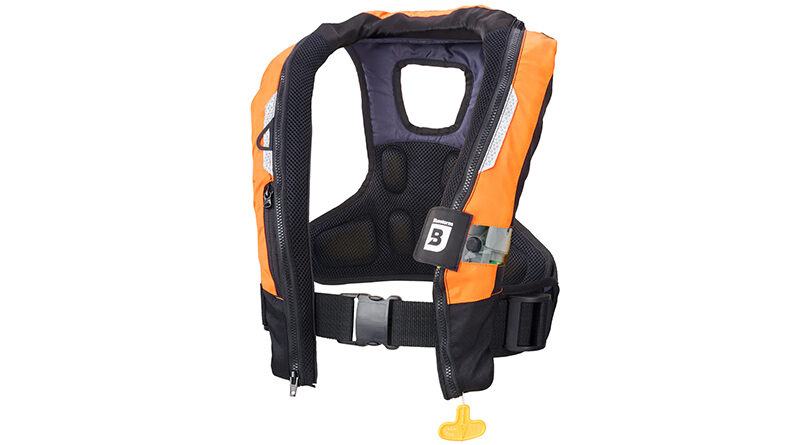Gear Up for Boating Season
Spring is just around the corner, waiting to beckon us to the sea with all the gear we need on our boats for fun, frolic and, of course, safety.
Auto-Inflatable PFDs
In order to ensure the safety of crew and passengers, we need to equip our boats with personal flotation devices (PFDs). You can get away with a stack of Type II orange PFDs for day sailing in and around your local harbor, but if you venture any farther, you need to invest in a set of inflatable PFDs, preferably auto-inflatable, offering the greatest chance of survival for all passengers and crew for several hours.
Mustang Survival USA, one of the most revered names in nautical safety, offers an array of PFDs, wet weather apparel and dry suits for both professional and cruising sailors. The Mustang MD3188 Inflatable Work Vest incorporates Hammar Hydrostatic Inflator Technology (HIT), which triggers a CO2 cartridge to fill the internal bladder, or inflation cell, automatically when the HIT system senses four inches of water depth.
The Arcus 40 PFD provides 40 pounds of buoyancy, roughly twice the buoyancy of an adult-size, throwable foam PFD. This PFD can fit a chest size of 30 to 56 inches, which should cover most sizes of crew. Although the manufacturer describes the Arcus 40 as a “Type 2” device, its features more closely resemble those of a Type 5 device, which includes auto-inflatable PFD vests. According to U.S. Coast Guard regulations, a true Type 5 vest includes a stainless steel buckle, while vests Type 1-3 usually feature a durable plastic buckle.
West Marine carries its own line of house-brand PFDs, and of all their models, the one most suited to offshore conditions is the A/M All Clear Offshore Inflatable Life Jacket. The cover is composed of a durable synthetic canvas available in red, blue or gray, and all of them include iridescent yellow green stripes, which enhance their visibility from a great distance.
Of all the PFD models you are likely to see, the A/M All Clear from West Marine certainly must have the widest size range, fitting any torso measuring 30 to 65 inches, which covers just about every torso size from Gilligan to the Skipper. A wide neoprene neck ensures a comfortable fit while wearing the PFD for long stretches of time.
Handheld VHF/AIS Radio
Although the USCG does not require a VHF radio on boats under 65.5 feet, it is unthinkable to head off into coastal waters on any craft without this vital piece of equipment. And by the way, your cell phone does not suffice as a marine radio.
If your vessel is in distress and you do not know your exact location, one easy way for emergency services to find you is by radio direction finder (RDF). Your cell phone communicates via digital signals with land-based cell towers and are virtually impossible to sort out via RDF.
And with AIS (automatic identification system), other vessels can identify your vessel name on their chartplotters and head directly to your location while staying in contact with you on the radio.
A leader in this new technology is the ICOM M94D Handheld VHF DSC AIS Transceiver. The M94D features a lithium-ion battery with 10 hours of battery life and a dot matrix grayscale LCD display. With 6W of transmit power, it’s just a bit more powerful than the typical 5W handheld radios we have become accustomed to over the last couple of decades.
As with base-mount AIS-capable VHF radios, the M94D presents a digital display of surrounding vessels, each one identified by name and MMSI (Maritime Mobile Service Identity) code, which is issued to the vessel by the FCC.
Standard Horizon also makes its version of handheld VHF/AIS/DSC technology available through its HX890NB Floating 6W Class H DSC Handheld VHF/GPS Radio. With the GPS function, you can enter waypoints as you would with any other non-charting GPS unit, such as the venerable Garmin 128, which I used on my circumnavigation aboard the 1966 Cal 30 Saltaire. I would have loved having that kind of GPS function combined with a VHF radio and AIS capability.
Oil and Fuel Filters
One way to ensure your engine is healthy and ready to perform at a moment’s notice is changing the oil and fuel filters at the beginning of each season. Particularly with fuel filters and water separators, keeping these items in top shape can mean the difference between getting back home or remaining stuck in an anchorage.
Sierra, Quicksilver, Mercury and Fram are among the most popular suppliers of both fuel and oil filters. For both gasoline and diesel engines, your boat should have a water separator and filter for the primary filter system. The secondary filter, connected to the engine, removes finer particles that may have passed through the primary filter.
And remember, always deposit used oil and filters in an approved oil dumping tank, which you should be able to find at your marina.
There are certainly other measures you can take to ensure safe coastal boating journeys. But as long as you have PFDs aboard, along with emergency communication devices and a properly maintained engine, you can expect your coastal boating journeys to be fun and safe.


